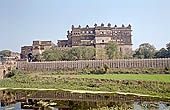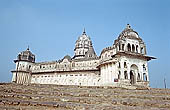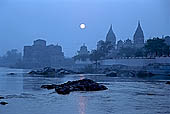On the bank of the Betwa river, in front of a quaint hamlet, approached by a multi-arched medieval bridge, in a walled island-fortress lays the deserted medieval royal citadel of Raja Rudra Pratap. With delicate chhatris (dome-shaped cenotaphs) and plasters, Orchha has a unique Indo-Islamic architectural legacy that influenced the Indo-Saracen Delhi architecture. Dating from the xvi until the xviii c. Orchha palaces are what remains of the fortunes of the Bundela kingdom, when Orchha was their capital. The incredibly weathered temples, palaces and cenotaphs today are haunted by monkeys and griffon vultures nesting in the palace domes.

|
Orchha
|
In Orchha there are two main areas: the palace area, built on a fortified island in the middle of the Betwa river, and the area with old large temples where the village is located. Moreover many ancient buildings, towers, and old gateways are scattered across the countryside.
Orchha |

|
The Palaces Area.
Orchha fort complex has three palaces set in an open quadrangle. The two biggest palaces are on either side of the Sheesh Mahal, now a hotel, that itself is a section of the palace complex.
Raj Mahal, a petite two-storied structure, this palace was the kings home (xvii c.), distinguishable by the uniformly cupola-lined parapets. The plain exteriors give way to interiors where some of the walls and ceilings are painted with vivid frescoes, depicting fantastic religious themes and floral patterns.
The Jahangir Mahal Palace distinguished by its decorated domed pavilions, balconies and an ornamental gateway flanked by stone elephants. It has delicate chhatris and ornate stone jalis (screens) along its outer walls that allow the light into the Mahal room interiors.
A pathway leads to the Rai Praveen Mahal; a low, two-storied palace which the brick structure matches the height of the trees of the close by Anand Mahal gardens.
The paths heading away from the palace complex leads you to other various small temples ruins amid local farmers fields.

|
Orchha
|
The Temples and the Royal Chattris.
The unused Chaturbhuj Mandir Temple (xvi c.) with its impressive spires looms hauntingly over Orchha village. With its peculiar design, it is closer to a cathedral rather than to a traditional Hindu temple. Built upon a massive stone platform and reached by a steep flight of steps, the never used Chaturbhuj Temple was specially constructed to enshrine the image of Lord Rama that remained in the palatial Ram Raja Temple. With its cruciform plan (representing the four-armed Vishnu) and expansive vaulted assembly hall, this seven storeys temple is architecturally interesting. A narrow spiral staircases takes you up to the temple roof for lovely views.
A main pilgrimage site for Hindus, the pink and yellow Ram Raja Mandir was originally meant as a palace for the queen, but eventually abdicated to host the image of Lord Rama that pertinaciously refused to relocate to its own brand new Chaturbhuj Mandir. Since then Orchha is the only place in India where Ram is worshipped as a Raja: uniformed policemen stamp to attention, rifles grounded, in their roles as bodyguards to His Highness. The legend says that Lord Ram is a nocturnal visitor in Orchha, hence the Ram Raja Temple remains closed throughout the day and the silver doors of the sanctum are open only for the evening aarti (entry not permitted to non-Hindus).
Orchha |

|
Close to the Ram Raja Mandir there is the Dinman Hardols Palace (called also the Palki Mahal) with the nearby two cooling towers (Sawar Badho pillars) part of an ingenious cooling system for the nearby palace, probably the only ones of their kind surviving in India, behind the palace, in an incredibly left to neglect the Phool Bagh, laid out as a Moghul formal garden you reach a rather strange shrine devoted to Dinman Hardol this saintly prince is worshipped by the young spouses.
On a hilltop the Lakshmi Narayan Mandir Temple (xvii c.) is reached following a stone path. It is built like a fort with high walls surrounding it. The interiors contain some very interesting wall paintings. Walls and ceiling of three halls are covered with murals with a variety of religious and mythical subjects as well as military battles scenes; unfortunately many have been defaced with graffiti.

|
Orchha
|
South of town, along the Kanchan Ghat, on the bank of the Betwa river the 14 sandstone Bundela Royal Chattris (cenotaphs), or memorials to the Bundelas rulers of Orchha. They combine elements of Mughal architecture, such as arches, and Hindu temple design, such as shikharas (spires).
On a very narrow bridge you can cross the river near a cataract, the ideal place to admire the sun setting with the backdrop of the cenotaphs. From here there is also the lure of the forest walking in the local Nature Reserve (very nice).
Orchha |

|
|
|
|
 |
|



